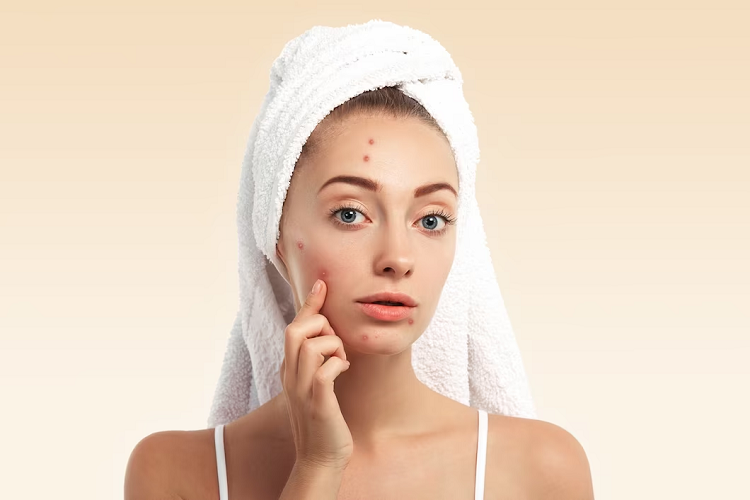In the world of skincare, few concerns are as vexing as Facial Redness. The sight of flushed cheeks or an inflamed forehead can make anyone feel self-conscious and eager to find a solution. Whether it’s an occasional bout of redness or a persistent issue, understanding the causes and discovering effective treatments is essential for achieving the calm, clear skin we all desire.

Understanding Facial Redness
Facial Redness is more than just a superficial annoyance. It refers to the visible reddening of the skin on the face, often accompanied by warmth and discomfort. This phenomenon is often a result of the dilation of blood vessels close to the skin’s surface.
Physiological and Psychological Factors The causes of face redness go beyond the superficial. Physiologically, blood vessels dilate due to triggers such as heat, cold, emotions, and inflammation. Moreover, psychological factors like stress can contribute to this skin issue, creating a complex interplay between mind and body.
Common Causes of Facial Redness
Facial redness can be caused by various factors, ranging from temporary conditions to more chronic or serious underlying issues. Here are some common causes of Facial Redness:
- Skin Irritation or Allergic Reaction: Exposure to irritants, such as harsh skincare products, certain fabrics, or environmental factors, can lead to redness. Allergic reactions to skincare products, makeup, or certain foods can also cause redness.
- Rosacea: Rosacea is a chronic skin condition that causes facial redness, visible blood vessels, and sometimes acne-like breakouts. It tends to worsen over time if not properly managed.
- Acne: Acne can cause redness due to inflammation and increased blood flow to the affected areas. Picking or popping pimples can exacerbate the redness.
- Sunburn: Overexposure to the sun’s ultraviolet (UV) rays can lead to sunburn, which is characterized by red, painful skin. Sunburn can also cause long-term damage to the skin and increase the risk of skin cancer.
- Temperature Changes: Sudden changes in temperature, such as going from a cold environment to a warm one, can cause temporary redness known as “cold-induced vasodilation.”
- Stress: Emotional stress can cause blood vessels to dilate, leading to face redness. This is often referred to as the “fight or flight” response.
- Alcohol Consumption: Alcohol can cause blood vessels to dilate, leading to flushed or red skin, especially in individuals who are sensitive to alcohol.
- Spicy Foods: Consuming spicy foods can cause temporary redness, often referred to as the “spicy flush.” This is due to the release of histamines in response to the capsaicin found in spicy foods.
- Medical Conditions: Certain medical conditions, such as lupus, dermatitis, and certain autoimmune disorders, can cause face redness as a symptom.
- Medications: Some medications, such as blood pressure medications, can cause face redness as a side effect.
- Exercise: Intense physical activity can lead to temporary facial redness due to increased blood flow and dilation of blood vessels.
- Hormonal Changes: Hormonal fluctuations, such as those that occur during pregnancy, menstruation, or menopause, can lead to temporary facial redness.
- Genetic Factors: Some individuals naturally have more sensitive skin that is prone to redness and flushing.
If you are experiencing persistent or severe facial redness that is causing discomfort or concern, it’s advisable to consult with a dermatologist or a healthcare professional. They can help identify the underlying cause and recommend appropriate treatments or lifestyle changes to manage the redness effectively.
Facial Redness Solutions and Treatments
It’s important to identify and address the cause of redness before starting any treatment. Here are some general approaches and treatments that can help manage facial redness.
Lifestyle Factors and Their Role
- Diet’s Impact on Skin Health: A diet rich in inflammatory foods can exacerbate face redness. Incorporating anti-inflammatory foods like fruits, vegetables, and omega-3 fatty acids can help manage redness.
- Alcohol Consumption and Face Flushing: Alcohol consumption is known to cause Face flushing, contributing to temporary redness. Moderation is key to preventing this issue. Stress and its connection to redness stress has a profound impact on the skin. Managing stress through relaxation techniques can help minimize flare-ups. Skincare products and harsh ingredients using harsh products or those with irritating ingredients can aggravate redness. Opt for gentle, hypoallergenic skincare products that nurture sensitive skin.
Environmental Influences
- Effects of Extreme Temperatures: Extreme temperatures, whether hot or cold, can trigger facial redness. Protecting your skin from these temperature changes is essential. Indoor and Outdoor Triggers Indoor heating and cooling systems can also contribute to facial redness. Be mindful of temperature variations and adjust your skincare routine accordingly.
- Pollution and Skin Sensitivity: Air pollution can exacerbate facial redness, especially in urban environments. Cleansing your skin thoroughly can help remove pollutants and reduce redness.
Effective Skincare Routine
- Gentle Cleansing for Sensitive Skin: Cleansing should be a gentle process, using mild cleansers that don’t strip the skin of its natural oils.
- Moisturization for Maintaining the Skin Barrier: A well-moisturized skin barrier is crucial in preventing redness. Use hydrating moisturizers to keep your skin healthy and protected. Choosing the Right Products Opt for skincare products labeled as hypoallergenic and non-comedogenic to minimize the risk of redness-inducing reactions.
- Sun Protection: The Importance of SPF Protecting your skin from the sun’s harmful rays is paramount. Use broad-spectrum sunscreen with a high SPF rating to shield against UV damage.
Advanced Skincare Treatments
- Topical Treatments for Anti-Inflammation: Topical creams with anti-inflammatory ingredients like niacinamide can help reduce redness and soothe the skin.
- Prescription Medications for Rosacea: Consult a skin specialist for prescription treatments that specifically target rosacea, such as topical antibiotics or anti-redness creams.
- Laser Therapy for Visible Blood Vessels: Laser treatments can effectively minimize visible blood vessels, reducing redness and enhancing skin appearance.
- Chemical Peels for Rejuvenation: Chemical peels can exfoliate the skin, revealing a fresher complexion and reducing redness caused by certain skin issues.
Natural Remedies and Home Treatments
- Aloe Vera’s Soothing Properties: Aloe vera’s natural anti-inflammatory properties make it an effective remedy for calming facial redness.
- Harnessing Green Tea’s Benefits: Green tea contains antioxidants that can reduce inflammation and redness when applied topically or consumed.
- Oatmeal Masks for Skin Calming: Oatmeal masks provide gentle exfoliation and soothe irritated skin, helping alleviate redness.
- DIY Face Serums with Essential Oils: Certain essential oils like chamomile and lavender have anti-inflammatory properties that can aid in reducing redness.
Makeup Tips and Techniques
- Color-Correcting Makeup Color-correcting makeup products can neutralize redness before applying foundation, creating a smoother base.
- Choosing the Right Foundation for Sensitive Skin Opt for foundations with soothing ingredients that won’t exacerbate redness in sensitive skin.
- Setting Sprays for Prolonged Wear Setting sprays can help your makeup last longer while also minimizing the appearance of redness.
Dietary Adjustments for Redness Reduction
- Incorporating Anti-Inflammatory Foods: Foods rich in antioxidants and omega-3 fatty acids can help reduce inflammation and redness.
- Foods to Avoid for Minimizing Flushing: Spicy foods and alcohol are known to trigger flushing and redness. Limiting their consumption can be beneficial.
- Importance of Hydration: Staying well-hydrated helps maintain skin health and can contribute to reducing facial redness.
Stress Management and Redness
- Stress-Reducing Activities: Practicing activities like yoga, meditation, and deep breathing can help manage stress and its impact on face redness.
- The Mind-Skin Connection: Understanding the relationship between stress and skin flare-ups can motivate individuals to prioritize stress reduction.
- Mindfulness Techniques for Skin Healht: Mindfulness practices can contribute to overall skin health by reducing stress-induced redness and inflammation.
- Professional Advice: Dermatologist Consultation:
- Recognizing Signs for Professional Help: Persistent and severe facial redness warrants consultation with a skin specialist for accurate diagnosis and treatment.
- Diagnostic Procedures for Underlying Causes: Skin specialists use various diagnostic methods to identify the root causes of facial redness, leading to targeted treatments.
- Customized Treatment Plans: Based on individual needs and underlying conditions, dermatologists create tailored treatment plans for effective redness management.
All treatments are not working the same for everyone, and what works best for you may vary based on the underlying cause of your facial redness. It’s important to consult a healthcare professional, preferably a dermatologist, for a proper diagnosis and tailored treatment recommendations. They can guide you toward the most effective treatment plan for your specific condition.
Facial Redness FAQs
Is facial redness a serious condition?
Facial redness can range from mild and temporary to a sign of an underlying medical condition. While some cases might not be serious and can be easily managed, others could be indicative of conditions like rosacea or allergies that might require medical attention.
Can stress cause facial redness?
Yes, stress can trigger facial redness, particularly in individuals with conditions like rosacea. Stress can lead to increased blood flow and inflammation, exacerbating redness.
Can diet affect facial redness?
Certain foods, especially spicy and hot items, can trigger redness, particularly in individuals with rosacea. It’s a good idea to monitor your diet and note if certain foods seem to exacerbate your redness.
Can I cover up redness with makeup?
Yes, makeup can help cover up facial redness temporarily. Look for products that are specifically formulated for sensitive or redness-prone skin. However, it’s important to address the underlying cause of the redness rather than relying solely on makeup.
Are there any home remedies for face redness?
For mild cases of facial redness due to sunburn or temporary irritation, you can try applying cool compresses, aloe vera gel, or products containing soothing ingredients like chamomile. However, if the redness persists or is due to an underlying condition, it’s best to consult a professional for advice.
Can I prevent facial redness?
Prevention strategies depend on the underlying cause. To prevent sunburn, use sunscreen and protective clothing. If you have rosacea, identify and avoid triggers, such as spicy foods and alcohol. For general skincare, use gentle products and avoid harsh chemicals.
Can laser treatments help with facial redness?
Yes, certain laser therapies, such as intense pulsed light (IPL) or vascular lasers, can be effective in treating facial redness, especially in cases of rosacea or visible blood vessels. However, these treatments should be administered by trained professionals.
Conclusion
Facial redness might be a common skin concern, but it’s far from insurmountable. Armed with knowledge about its causes and armed with effective treatments, you can unveil your best skin yet. By embracing a comprehensive approach that encompasses skincare, lifestyle adjustments, and professional guidance, you can bid farewell to facial redness and say hello to a more confident, radiant you.


